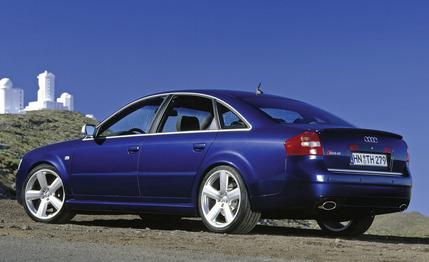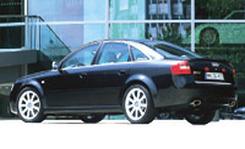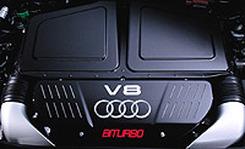
 First Drive Review
First Drive Review
To use the new 450-hp Audi RS 6 as your grocery-getting daily driver is to use a broadsword as a butter knife. Looking very much like your average Audi A6, the RS 6 is glorious overkill.
Audi claims this 4050-pound all-wheel-drive sedan--third in a line of RS hot-rod Audis and the first to be sold in the U.S.--sprints to 60 mph in 4.6 seconds. That's faster than the Mercedes E55 AMG by almost a second and fractionally faster than the manual-transmission BMW M5. The Audi easily reached an indicated 174 mph on the unlimited portion of the A92 autobahn near Munich. And so easily and with such supernatural stability does it maintain that speed that we found ourselves noodling with the navigation system while our co-driver bumped against the speed limiter. The limiter is set at 155 mph for all markets, so our test car had either a lazy limiter or an optimistic speedometer. 

Either way, 155 mph or 174 mph, it doesn't really matter. Germany is the only place we know where one can fully exploit this car's greatest trick--providing great speed along with great composure.
What we have here is a grand German game of wonderfully irrational one-upmanship. Mercedes offers 349 horsepower in the E55 AMG? BMW has 394 horses in the M5? Then Audi will produce 450.
In the engine room of the RS is a hot version of the 4.2-liter, five-valve DOHC V-8 that powers the A8 and the upper-level A6. It has been worked over by Quattro GmbH. "Quattro" is usually a reference to Audi's all-wheel-drive system, but here it applies to a performance arm of the company that is to compete with the M group at BMW and Mercedes' AMG.


Two turbochargers have been bolted to the 4.2-liter engine, which in stock guise makes between 300 and 360 horsepower, depending on application. They blow a maximum of 11.6 psi of pressure and come with twin air-to-air intercoolers. The cylinder heads are modified for better airflow and cooling. The two exhaust valves per cylinder are sodium-filled to keep them cool. Freer-flowing intake and exhaust result in 415 pound-feet of torque delivered over a flat plateau between 1950 and 5600 rpm to go with the 450 horses. Its delivery is fluid and almost electric in its smoothness.
And that performance comes while routing the power through a five-speed automatic transmission, the only gearbox available. Audi says there isn't a manual gearbox under parent VW's corporate umbrella that can handle this much power. So the RS 6 uses the tranny from the 414-hp A8 W-12 (a car not sold in the U.S.). With this much torque and the quick shifts in either standard or sport mode, we didn't mind giving our clutch-pedal leg a rest. Should you want to choose your own gears, Audi provides shift paddles behind the steering wheel.
When you need to slow the car more quickly than a downshift would accomplish--which you often will in this beast--Audi has you covered. Massive eight-piston Brembo calipers clamp down on 14.4-inch rotors in front, and single-piston calipers with 13.2-inch rotors handle the braking in back. Audi has upped the braking-technology ante as well. In place of a traditional rotor is a friction ring (the circular part where the pads contact) connected to an aluminum hub by 14 short pins. The pins allow the friction ring to move one millimeter either outboard or inboard. Audi says this allows the friction ring to stay in perfect alignment with the pad surface under extreme conditions. The arrangement also allows for better cooling and less unsprung weight. With full pressure on the brake pedal, the force of deceleration is nothing short of staggering, although the brakes on our prototype had a softer brake-pedal action than we'd like. We'll have to test a production car before we pass judgment on feel.
The RS 6's suspension is equally trick. The car comes standard with a semiactive suspension system called Dynamic Ride Control (DRC). Unlike Mercedes' electronically controlled ABC pitch-and-roll-control active suspension, DRC is strictly mechanical--hydraulic lines that connect diagonally opposed single-tube shocks through a central reservoir and valve. Shock fluid can move around the car to selectively change the damping characteristics of the various corners. For instance, in an aggressive cornering maneuver, as hydraulic pressure in the shocks on the inside of the corner is reduced, hydraulic fluid and pressure move to the diagonal outside shocks, stiffening them to reduce roll. Yamaha developed the system for its racing motorcycles. The result is a reasonably soft ride (at least over well-maintained roads in Germany) and generally good body control for a two-ton sedan.
Audi also stiffened the shocks by 40 percent and the springs by 30 percent, compared with the A6 4.2 model. The entire suspension of the RS 6 is made of aluminum, including the front and rear subframes. To this Audi adds 18-inch aluminum wheels wearing 255/40ZR-18 Pirelli P Zero Rosso tires at all four corners.
The wheels and tires are the visual clues that this A6 is something special. Otherwise, the RS 6 has restrained styling. There's a new front fascia incorporating intakes for the intercoolers, a new rear fascia to incorporate the large twin exhaust tips, a small rear spoiler to reduce aerodynamic lift at high speeds, and matte aluminum trim. The interior is near-standard Audi, but with the addition of special wood trim or carbon fiber as a no-cost option and perforated leather on the steering wheel and shift knob. Everything is standard but the navigation system and the rear side airbags.
Standard equipment, however, will not be what motivates buyers to step up to the estimated price (Audi officially says only that it will be "less than $85,000"). That estimate would make the RS 6 almost $10,000 more expensive than a BMW M5 or Mercedes E55 AMG. With only 860 RS 6 sedans destined for delivery to the U.S. starting next year, Audi believes there are plenty of people who will happily pay that much for massive overkill and grand one-upmanship.